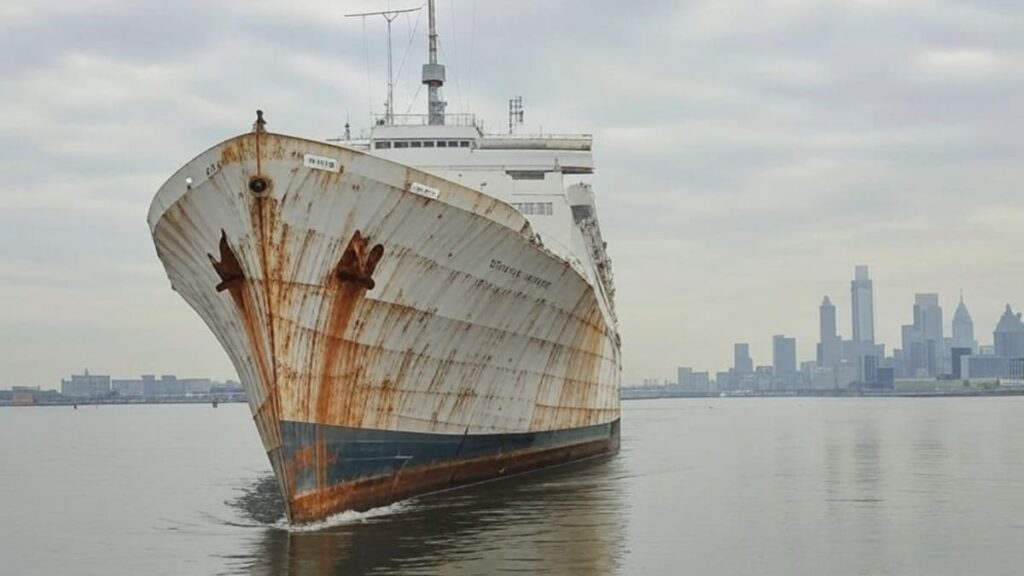Once hailed as the pinnacle of maritime engineering, the SS United States was crafted to dominate the Atlantic. After years of decline, this iconic vessel is set to undergo an extraordinary metamorphosis: it will become a vast artificial reef, settling into the ocean’s depths.
The Rise of an Icon
In March 2024, the once-majestic SS United States was finally relocated from its long-standing dock in Philadelphia after nearly three decades of neglect. This massive ship, which once represented American ingenuity and technological prowess, had been left to wither away, its former glory fading. However, instead of being scrapped, the SS United States is poised for a remarkable new chapter, one that will serve both ecological and recreational purposes.
To grasp the importance of this historic vessel, it’s essential to revisit its origins. Following World War II, the United States aimed to showcase its might and advanced technology amid the onset of the Cold War. Constructed at Newport News Shipbuilding in Virginia, the SS United States was an engineering marvel of its time. Spanning 1,000 feet and displacing over 47,000 tons, it was an imposing figure on the water.
Comparatively, the SS United States dwarfed other ships of its era, including the infamous Titanic. While modern cruise liners like the Harmony of the Seas may surpass its dimensions, the SS United States was the largest and arguably the fastest of its time.
A Vessel of Records
Upon its launch in 1952, the SS United States achieved an unprecedented record for crossing the Atlantic, a feat that would remain unmatched for decades. With remarkable speed, it journeyed from New York to Europe in merely three days, ten hours, and 40 minutes, outpacing its predecessor, the Queen Mary, and claiming the illustrious Blue Riband title.
This majestic vessel was not only a technological wonder but also held a significant secret: it was designed as a rapid troop transport for wartime scenarios. Its unique dual-purpose design allowed it to accommodate up to 15,000 soldiers globally at remarkable speeds. Although the SS United States never fulfilled this military role, it remains a testament to American engineering’s versatility and ambition.
However, the advent of jet air travel in the late 1960s rapidly rendered transatlantic ocean travel outdated. As flying became faster and more cost-effective, operating a vessel as large and fuel-intensive as the SS United States became economically unviable. Thus, in 1969, after only 17 years in service, it was retired from commercial operations.
Years of Neglect and Renewed Hope
The ship’s retirement marked a prolonged period of uncertainty. Changing hands multiple times, it was left to drift as a relic of a bygone era, with no consensus on its fate. Numerous proposals to convert it into a luxury hotel, casino, or museum floundered due to exorbitant renovation costs. In 1996, it was finally docked in Philadelphia, where it languished in decay, stripped of its former glory.
Yet, a beacon of hope emerged through the efforts of the SS United States Conservancy, an organization of enthusiasts dedicated to preserving the ship from disassembly. After years of tireless fundraising and advocacy, they have secured a meaningful legacy for the vessel—not in a scrapyard, but as a vital part of an ecological initiative.
A Colossal Transformation
In 2024, plans were finalized for the SS United States to be transformed into a massive artificial reef off the coast of Alabama. By 2026, the ship is slated for a deliberate sinking, creating an innovative habitat for marine life and an exciting destination for divers. The initiative will also feature a land-based museum and interpretation center, showcasing artifacts from the ship, including the iconic radar tower.
This transformation into an artificial reef not only preserves the ship’s legacy but also enhances the marine ecosystem. Experts predict that the vessel’s new role will foster habitats for fish and other ocean life, becoming a significant site for conservation and diving enthusiasts.
A Fitting Farewell to a Giant
From its golden era as the fastest ship across the Atlantic to its impending role as a sanctuary for marine life, the SS United States reflects the full circle of triumph and decline. This final chapter is a poignant tribute, allowing the ship to continue serving the planet in a groundbreaking new capacity.
As it rests at the ocean’s floor, the SS United States will remain a beacon of human ingenuity and ambition. It will stand not merely as a monument of engineering prowess, but rather as a testament to the synergy between humanity and the natural world—a lasting legacy for a ship that defied the odds and continues to do so, even in its twilight.







